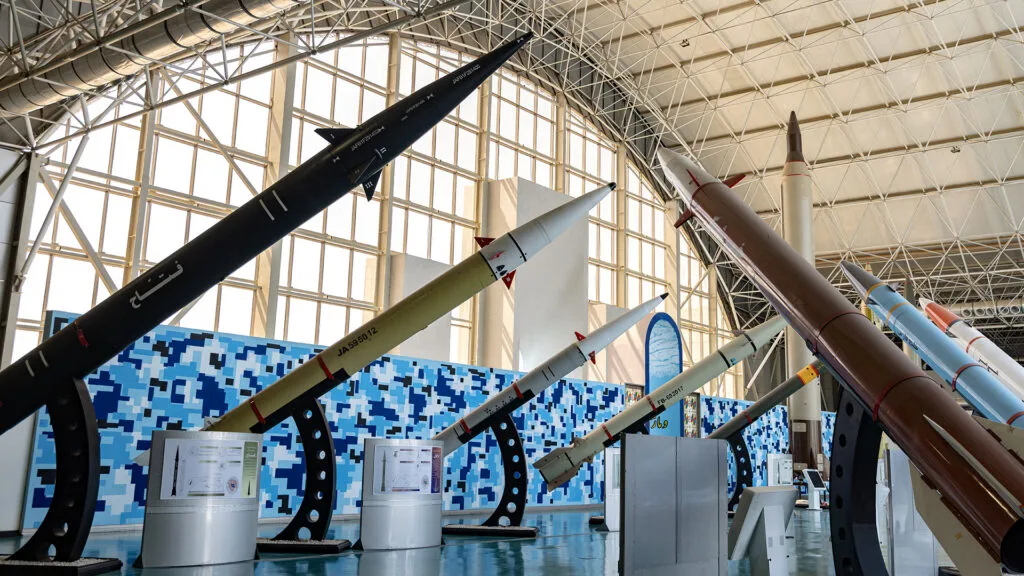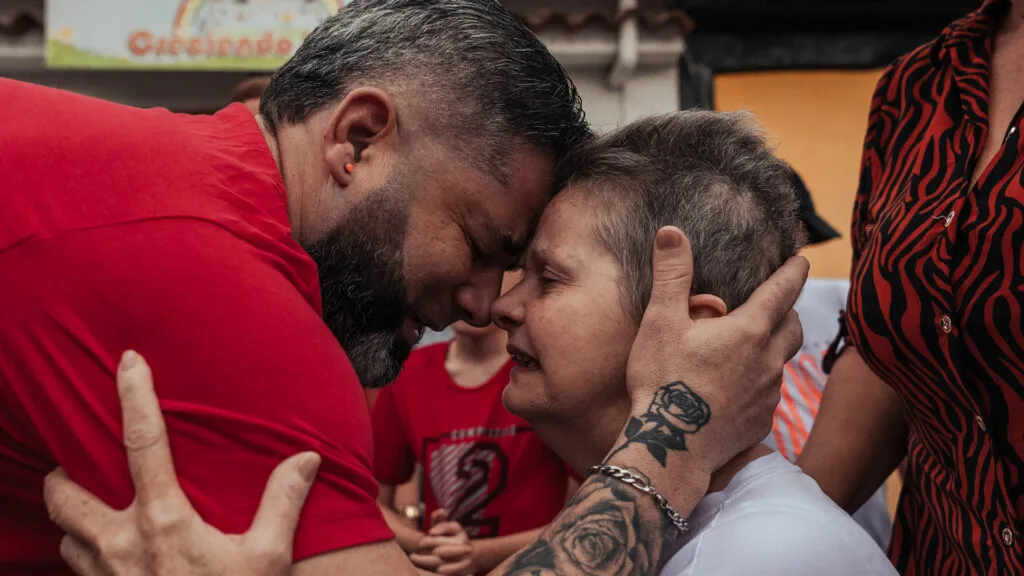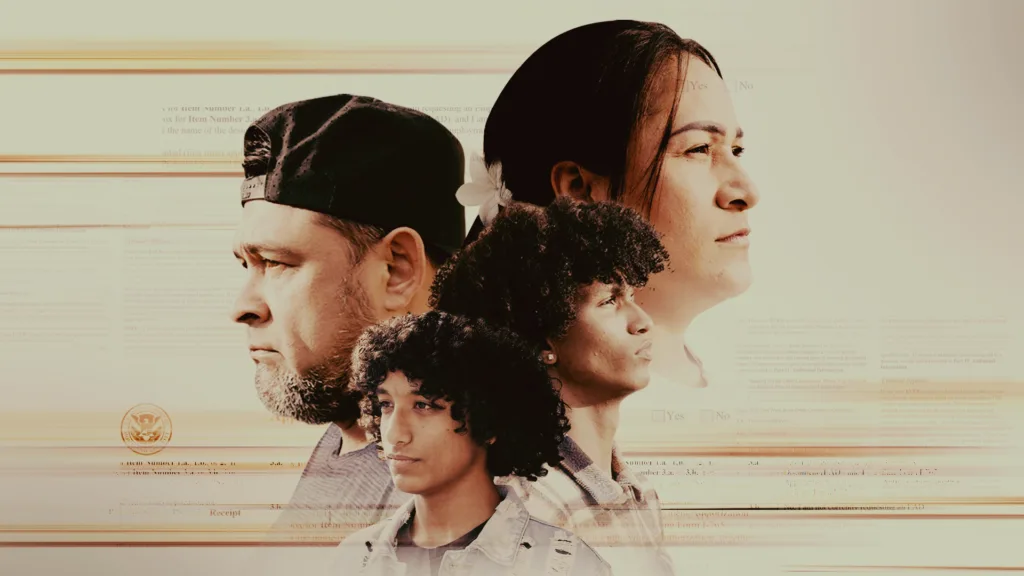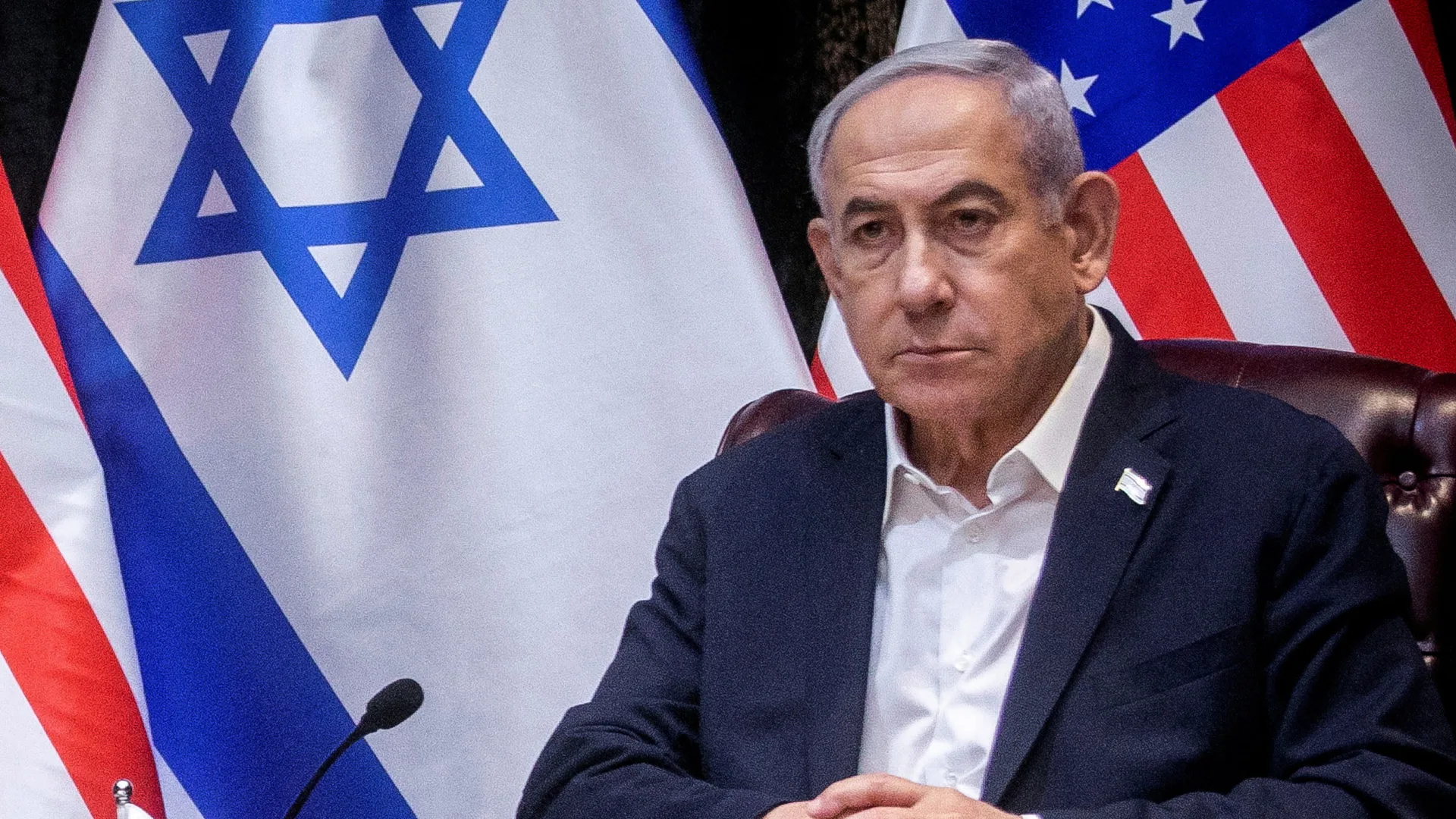Timeline: War and Peace Between Israelis and Palestinians, From Oslo to Gaza
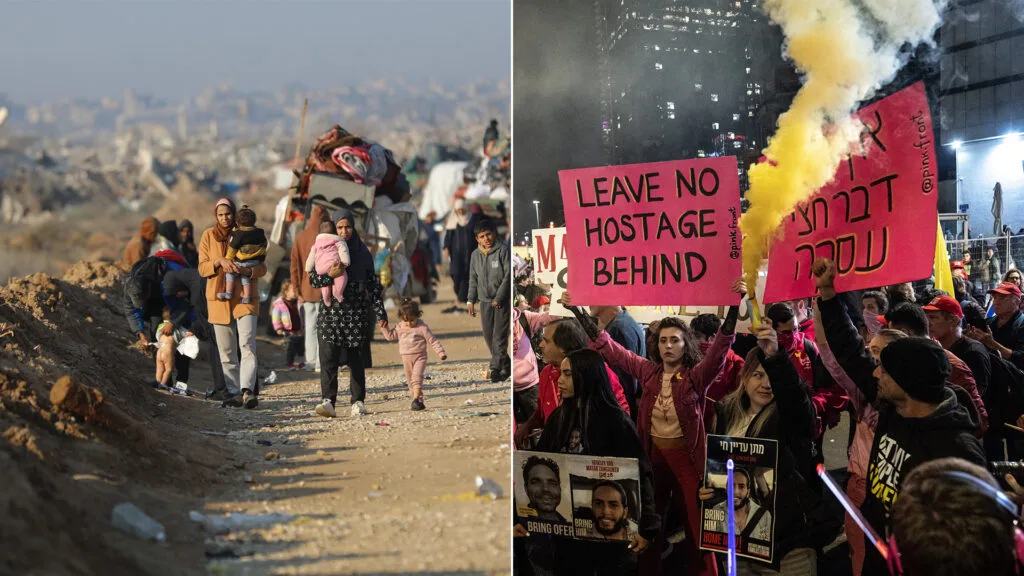
November 7, 2023
Share
This timeline was last updated on Jan. 31, 2025.
The Israel-Hamas war brought renewed attention to the enduring Israeli-Palestinian conflict.
This timeline chronicles some of the major events that shaped Israeli-Palestinian relations within the past three decades — from the 1993 Oslo peace agreement to the Hamas terror attack on Israel on Oct. 7, 2023, and Israel’s war in Gaza that has killed thousands of Palestinians. Many of these moments are featured in FRONTLINE’s documentaries, from the 2002 film Shattered Dreams of Peace, to our recent reporting on the conflict, including Netanyahu, America & the Road to War in Gaza, Failure at the Fence, Israel’s Second Front and A Year of War: Israelis and Palestinians.
SEPT. 13, 1993 The historic Oslo Accord is signed at the White House. Palestinians and Israelis agree to recognize the other’s right to exist: “It is time to put an end to decades of confrontation and conflict” and “strive to live in peaceful coexistence and mutual dignity and security and achieve a just, lasting, and comprehensive peace.” Soon Israel begins its promised withdrawal from lands occupied since the 1967 war; Jericho and Gaza are transferred to the Palestinians. Yasser Arafat — Israel’s implacable enemy for 30 years — returns from exile to establish the Palestinian Authority. The parties agree that the most sensitive “final status” issues — permanent borders, Jewish settlements, Palestinian refugees, and Jerusalem — will be addressed later.
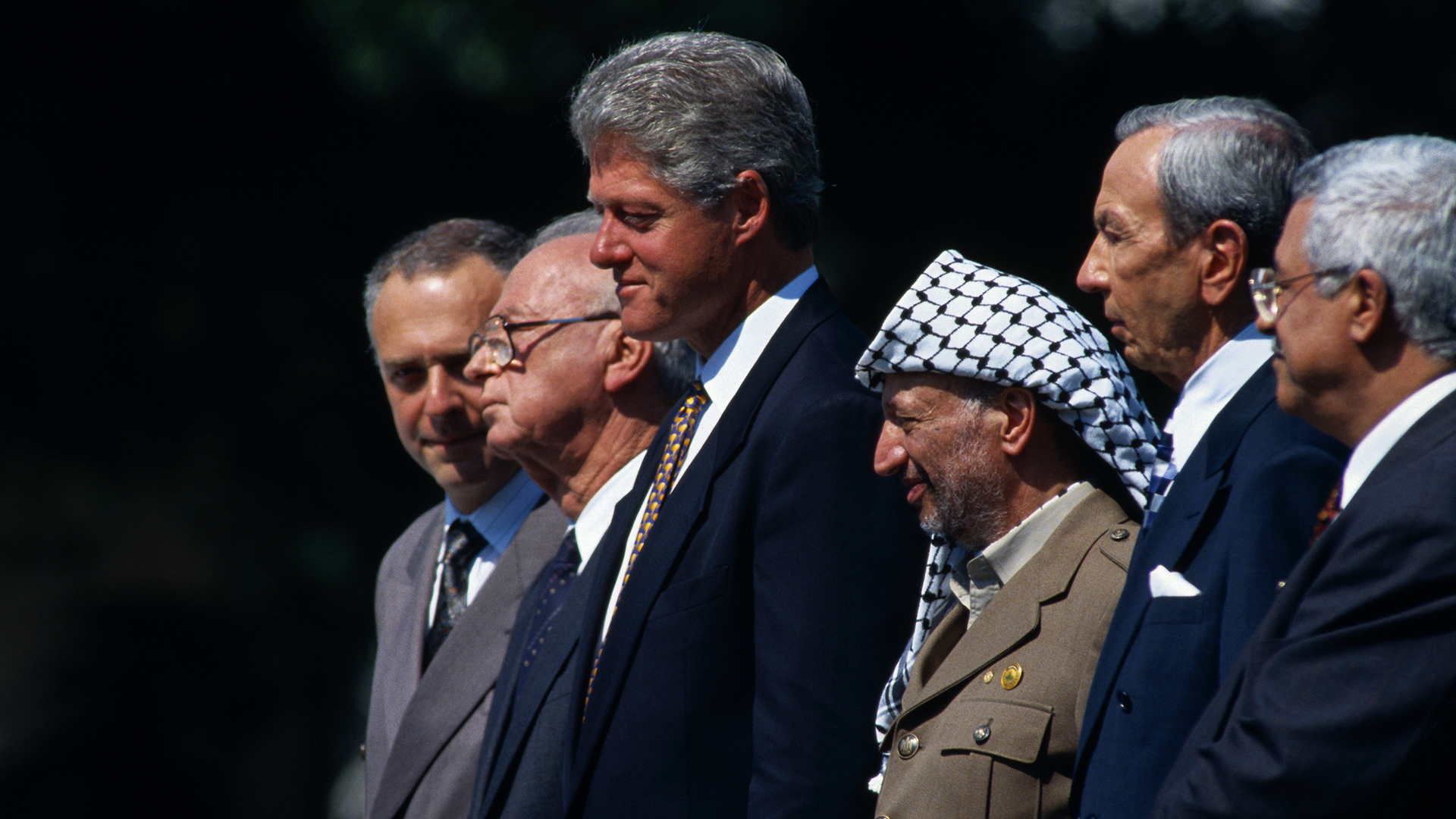
OCT. 14, 1994 Israeli Prime Minister Yitzhak Rabin, Israeli Foreign Minister Shimon Peres, and Yasser Arafat are awarded the Nobel Peace Prize for their roles in the Oslo Accord.
SEPT. 28, 1995 In Washington, D.C., Rabin and Arafat sign the Oslo II agreement, which provides for Palestinian self-rule in parts of the West Bank and also sets the framework for Palestinian elections. Under Oslo II, the West Bank is divided into three areas: Area A, which is under exclusive Palestinian control; Area B, where Palestinians have civilian control and Israelis control security; and Area C, which is controlled exclusively by Israel. The following week, the agreement is ratified by a slim margin in the Knesset, Israel’s parliament, where Rabin faces harsh criticism from those in the conservative Likud Party.
NOV. 4, 1995 Following a peace rally in Tel Aviv, Yitzhak Rabin is assassinated by a Jewish extremist. He is succeeded by Peres.
DEC. 8, 1995 Arafat and Peres meet to reaffirm their commitment to the Oslo Accords. Israel would release 1,000 Palestinian prisoners. By the end of the month, Israel has also withdrawn its troops from an additional five major Palestinian cities.
Within the Israeli opposition, these concessions are seen as a dangerous strategic mistake. And while many Palestinians rejoice, some — including those in the militant Islamist group Hamas, which gained power among Palestinians by controlling mosques and providing food and education to the poor, and had carried out suicide bombings inside Israel — oppose any compromise.
JAN. 20, 1996 Palestinian elections are held as required by the Oslo Accord. Hamas, protesting peace negotiations with Israel, calls for an election boycott . But Palestinians endorse the peace process by giving Arafat an overwhelming victory.
FEB. 25 – MARCH 4, 1996 Several weeks after Israel assassinates Hamas’ chief bomb-maker, Hamas retaliates. Three suicide attacks in eight days leave 46 dead and hundreds wounded. Then, on March 4, 1996, a fourth suicide bomber explodes himself, this time in a Tel Aviv mall. Thirteen people are killed and 157 more wounded; the dead are all under 17 years old. Arafat orders his security forces to move against the Islamist militants and hundreds are arrested. The peace process — and its principal advocate, Shimon Peres — comes under increasing attack.
MARCH 13, 1996 Israeli opposition to the peace process coalesces around Benjamin Netanyahu, the new leader of the Likud Party who is poised to challenge Peres and his Labor Party in the upcoming election. Fearing Peres’ defeat and the demise of the peace process, Egypt and the United States convene world leaders in the Sinai resort of Sharm el-Sheik. They call it the Summit of Peacemakers and hope to influence the Israeli electorate to support Peres.
APRIL 11-18, 1996 Violence erupts along Israel’s northern border. Hezbollah, an Iran-backed Lebanese militant group that shares Hamas’ opposition to the peace process, fires missiles into Israeli villages and towns, prompting Israel to launch a massive bombardment of Hezbollah bases in southern Lebanon. A week later, in a case of mistaken targeting, Israeli artillery hit a United Nations compound near the village of Kana, where civilians have sought shelter from the attacks. More than 100 are killed.
Israeli Arabs, fervent supporters of Peres and his Labor Party, are now outraged and turn against him, calling for a boycott of the upcoming election.
MAY 29, 1996 Since Israeli Arabs constitute 20% of Israel’s population, their boycott of the election helps elect Netanyahu: He defeats Peres by a mere 1%. At 47, Netanyahu becomes Israel’s youngest prime minister.
SEPT. 4, 1996 Arafat and Netanyahu meet at the Erez border crossing between Gaza and Israel. The meeting between the two men is fraught with tension, but their handshake, though largely ceremonial, is still a symbol of hope.
SEPT. 24, 1996 In an area extremely sensitive to both Muslims and Jews — where the Al Aqsa mosque on the Temple Mount sits above the Western Wall — Netanyahu changes the status quo and opens an ancient tunnel that runs along the wall. Netanyahu’s security advisers had warned him against opening the tunnel, fearing that the move was too provocative.
Palestinian radicals are quick to exploit the situation and organize demonstrations. The Israeli army fires upon the demonstrators and for the first time since the Oslo Accord was signed, the Palestinian police use their guns against the Israeli army. Netanyahu gives the order to move Israel’s tank forces into striking positions. The violence leaves 59 Palestinians and 16 Israelis dead. Hundreds more are wounded on both sides before Palestinian and Israeli security forces cooperate to bring an end to the fighting.
OCT. 1 – 2, 1996 In an attempt to prevent further violence and restart negotiations, Arafat and Netanyahu are summoned to Washington by U.S. President Bill Clinton. Clinton also asks King Hussein of Jordan to join the talks. By the end of the summit, Netanyahu and Arafat agree to resume talks on further implementation of the Oslo Accords.
JAN. 15, 1997 After four months of difficult negotiations, Israel agrees to withdraw from Hebron, leaving behind only a small enclave of Jewish settlers. Now Arafat’s Palestinian Authority controls all of the major cities in the West Bank and Gaza. Palestinians cheer the withdrawal, but Jewish settlers feel betrayed by Netanyahu.
MARCH 18, 1997 Three weeks after Netanyahu gives the green light, construction begins on a settlement on a contested hill near Jerusalem. Although Jewish settlements were not mentioned specifically in the Oslo Accords, Rabin had promised that no additional ones would be built. Tensions are high.
MARCH 21, 1997 In Tel Aviv, a suicide bomber explodes himself in a packed café. Hamas claims responsibility.
JULY 30, 1997 Two suicide attacks rip through Jerusalem’s main market within 10 minutes of each other. Sixteen are killed and hundreds are wounded. In response, Israel limits access in and out of Palestinian territories and enforces a strict curfew.
SEPT. 4, 1997 Three more suicide bombers strike at the heart of Jerusalem. Five Israelis are killed and more than 200 wounded. Netanyahu declares that no more land will be handed over to the Palestinians as long as terror continues.
SEPT. 14, 1997 Netanyahu allows Jewish settlers to occupy houses within Arab sections of Jerusalem, once again changing the status quo. Palestinians demonstrating against Jewish settlers are joined by groups of Israelis who oppose Netanyahu’s policies.
OCT. 15 – 23, 1998 The U.S. calls a meeting in another attempt to revive the peace process. At first, the two sides are mired in disagreements. But after Clinton pushes a marathon 21-hour session, both Palestinians and Israelis agree to what becomes known as the Wye River Memorandum.
The agreement allows for the construction of an international airport for the Palestinians in the Gaza Strip. Israel agrees to pull back its forces from an additional 13% of the West Bank and to release 750 Palestinian prisoners. (Ultimately, only half of the pull-back is finished and only 250 prisoners are released.) The Palestinian Authority agrees to combat terrorist organizations, to arrest those involved in terrorist activities, and to collect all illegal weapons and explosives. (Little or none of this is ever done.)
DEC. 12 – 14, 1998 Clinton comes to Gaza to lend his prestige to the implementation of portions of the Wye agreements. In Clinton’s presence, the Palestinian National Council takes a historic step: Its members vote to rescind the clause in the PLO Charter that calls for the destruction of the State of Israel. The extremists Arafat is supposed to control stage violent protests against the recognition of Israel.
JAN. 4, 1999 In Israel, the people who had brought Netanyahu into power see the handover of more territory — as called for by Wye — as an act of betrayal. The Knesset convenes in an extraordinary session. Over two-thirds of its members — from all across the political spectrum — rebuke Netanyahu and call for new elections. Opposing Netanyahu is Labor Party head Ehud Barak, a former chief of staff, Israel’s most decorated military hero, and a disciple of the late Prime Minister Yitzhak Rabin. He runs on a platform of peace and reconciliation with the Palestinians.
MAY 17, 1999 Barak wins a landslide victory, becoming Israel’s 14th prime minister. While his mandate is strong, Barak wants to push quickly for a permanent agreement, skipping the interim Israeli redeployments called for in the Wye accords. He envisions a two-state solution that will finally put an end to the conflict.
JULY 11, 1999 Barak flies to the Erez crossing on the Israel-Gaza border for his first official meeting with the Palestinian leadership. The Palestinians expect to obtain a commitment from Barak to immediately implement the long-delayed Israeli redeployment. Barak dismisses the idea and the talks disintegrate.
SEPT. 3 – 5, 1999 After five weeks of talks between the two principal negotiators — Saeb Erekat for the Palestinians; Gilead Sher for Israel — the two sides agree on a bold framework and timetable for the final peace agreement. It is signed by Arafat and Barak. The Palestinian and Israeli delegations assemble in Egypt at Sharm el-Sheik to celebrate the fruits of the negotiators’ efforts. As a confidence-building measure, Israel agrees to release 350 prisoners in two phases. The Palestinians agree to enforce the existing security understandings.
NOVEMBER 1999 Land and the settlements — still expanding under Barak — become the main issues when negotiations resume. Questions remain over the 180,000 Israeli settlers in the West Bank and Gaza and how much land Israel will cede to the Palestinians. The Palestinians are outraged by the Israeli proposal, saying that it would cut the West Bank in three parts and allow Israel to continue the settlements.
Not long after, secret negotiations in Stockholm deal with another contentious issue — the Palestinian refugees. Three million displaced people demand the right to return, a number roughly equal to half of the population of Israel. Their return would alter the nature of the Jewish state.
MAY 24, 2000 Barak fulfills a campaign promise and ends Israel’s 22-year occupation of southern Lebanon. Hezbollah, which had been fighting the Israeli army in Lebanon for years, sees Israel’s flight as a massive victory. Many Palestinians now believe they, too, can achieve their aims by fighting rather than negotiating.
In Israel, Barak is under fire for his withdrawal from Lebanon and for being ineffectual with the Palestinians. He urges Clinton to hold a summit to resolve everything once and for all.
JULY 11 – 25, 2000 The leaders head off to a hastily prepared summit at Camp David. Issues never before discussed at senior levels between Israelis and Palestinians — Jerusalem, statehood, boundaries, refugees — are put on the table.
To break the impasse over the West Bank, Clinton proposes a compromise: Israel would return almost all of the West Bank and Gaza to the Palestinians; the two sides would swap small parcels of land important to each other; and they would agree to share control of Jerusalem. Barak uses Clinton’s proposal as a starting point and suggests several changes. Arafat never replies and Barak then refuses to negotiate with Arafat directly.
When Clinton returns to Camp David, Jerusalem is again put on the table. Arafat argues that the Jews have no claim at all to the area of the Temple Mount. On the last night of the talks, Clinton offers a new bridging proposal that covers all the issues, including the main stumbling block of east Jerusalem. But Arafat refuses any compromise over the Temple Mount and is concerned with limits on the sovereignty for the new Palestinian entity (the Clinton/Barak plan would have left the new Palestinian state with significant loss of water and good land, almost split by Israeli annexation running east from Jerusalem, and with Israel getting roughly 9% of the West Bank). Arafat rejects the proposal.
Arafat returns home to a hero’s welcome. Calls for an uprising — a new intifada — are heavy in the air. Despite the official demise of the talks, Arafat and Barak approve a new series of secret meetings between the negotiators.
SEPT. 25, 2000 Arafat visits Barak at his private residence. According to many of those present, the meeting goes well. At the end of the evening, Arafat makes a request of Barak: that Ariel Sharon, the head of Israel’s right-wing Likud Party, be denied permission to visit the Temple Mount. Barak, however, cannot prevent Sharon’s visit. Instead, he coordinates with the Palestinian Authority, which agrees to try to keep peace in the area.
SEPT. 28, 2000 The Al-Aqsa intifada, or uprising, is born after Sharon’s visit to the Temple Mount. By day’s end, seven protestors are dead and 160 injured. The riots spread quickly throughout the West Bank and Gaza and engulf the Israeli Arab community as well. After a week of fighting, 50 Palestinians and five Israelis are dead.
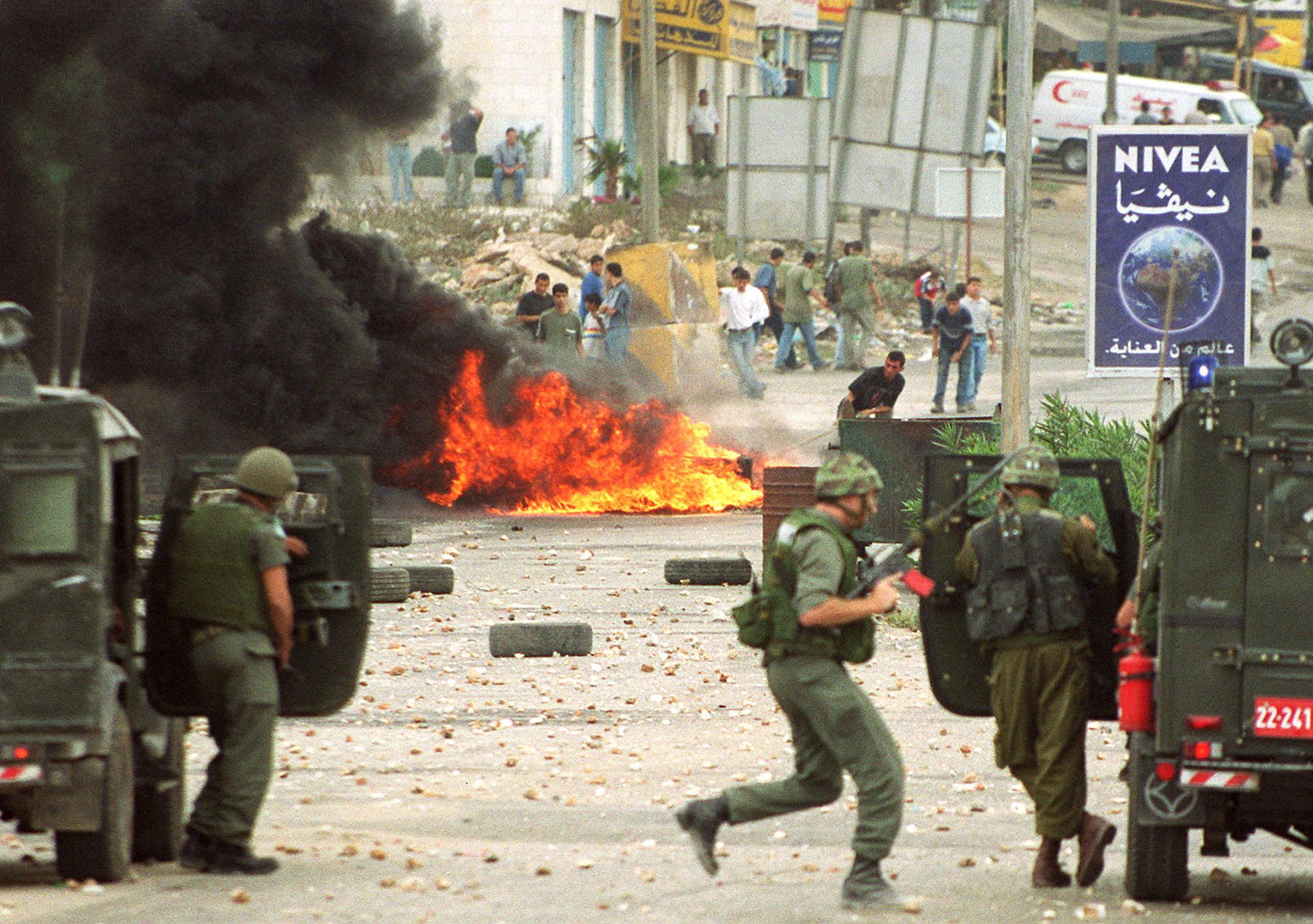
OCT. 12, 2000 Two Israeli reservists accidentally stray into Palestinian territory and are lynched by a Palestinian mob. Israel blames the Palestinian Authority for the murders and within hours attack-helicopters destroy the police station, the site of the lynching. Israel also launches massive attacks on other targets in Gaza and the West Bank.
In Israel, Barak’s policies are blamed for the rapidly deteriorating situation. Even among his staunchest supporters, many now distrust the Palestinians’ intentions.
DEC. 9, 2000 By resigning Barak obtains a window of 60 days to regain support before standing for reelection. But the violence has made his pro-negotiation stance difficult to defend.
Likud leader Sharon — the hard-line former general whose visit to the Temple Mount sparked the intifada — runs on a platform of security and is far ahead in the polls. Barak’s only hope is to conclude a deal with the Palestinians quickly.
JAN. 21 – 27, 2001 In a desperate attempt to reach an agreement before the election, negotiators meet in the resort town of Taba, Egypt, focusing on a new framework for an agreement that had been developed by Clinton the previous month. The new terms go further than what Israel and the U.S. had offered at Camp David. The negotiators move rapidly toward reconciling the differences in this new framework, but they run out of political time. They are unable to conclude an agreement with Clinton now out of office and Barak standing for reelection in two weeks.
FEB. 6, 2001 Sharon is elected prime minister of Israel, defeating Barak in a landslide. Soon, the political process stops and the cycle of violence and counterviolence continues. Palestinian suicide bombings become an almost daily event. Israeli retaliation leaves hundreds of Palestinians dead.
MARCH 29, 2002 Two days after a suicide bomber explodes himself in a Netanya hotel on Passover and kills 30 people, Israel launches Operation Defensive Shield. With overwhelming force, Israeli troops reenter Palestinian cities and refugee camps, hunting down terrorists and often leaving massive destruction in their wake. In Ramallah, Israeli forces enter Arafat’s compound and he is confined.
JUNE 18 – 19, 2002 Two bombings kill more than two dozen Israelis in Jerusalem. Arafat denounces the attacks, saying they “have nothing to do with our national rights in legitimate resistance to Israeli occupation.” Sharon announces Israel will immediately begin a policy of retaking land in the West Bank, and holding it, until the terror attacks stop. Sharon also authorizes the construction of a 217-mile fence along the West Bank which the Israeli government says will shield the country from terror attacks. Arafat calls it a “fascist, apartheid measure.”
Shattered Dreams of Peace: The Road From Oslo
APRIL 30, 2003 The Quartet of the Middle East — made up of the U.S., Russia, the European Union and the U.N. — proposes a Roadmap for Peace to resolve the Israeli-Palestinian conflict through a two-state solution. Despite multiple attempts, they are never able to implement it.
MARCH 22, 2004 An Israeli missile in Gaza kills Hamas founder and spiritual leader Sheikh Ahmed Yassin, whom Sharon called the “mastermind of Palestinian terror.” More than 200,000 Palestinians attend Yassin’s funeral procession; Palestinian militants threaten revenge.
NOV. 2004 – JAN 2005 After spending almost three years confined to his compound, Arafat dies on Nov. 11, 2004. Mahmoud Abbas is elected to succeed Arafat in a Jan. 9, 2005, election, becoming the new president of the Palestinian Authority. No presidential elections have been held since.
FEB. 8, 2005 Israeli Prime Minister Ariel Sharon and Palestinian leader Mahmoud Abbas announce a ceasefire, effectively ending the second intifada.
AUG. 15, 2005 Israel begins withdrawal of military forces and settlers from Gaza. It evacuates approximately 9,000 Israeli settlers from 25 settlements including four settlements in the West Bank. After withdrawal, the Israeli military remains in charge of Gaza’s airspace, coastline and borders — except for the Gaza-Egypt border, which Egypt is in charge of.
JAN. 4, 2006 Sharon suffers a stroke and falls into a coma. Ehud Olmert takes over as Israel’s prime minister.
JAN. 25, 2006 Hamas defeats the long-dominant Fatah party in parliamentary elections. Despite losing its majority, Fatah still controls the presidency. No parliamentary elections have been held since. A power struggle erupts between Hamas and Fatah.
APRIL 7, 2006 The U.S. and the EU suspend aid to the Hamas-run Palestinian government citing Hamas’ refusal to recognize Israel’s right to exist. The group has been designated a terrorist organization by the United States since 1997.
JUNE 25, 2006 Palestinian militants, including those from Hamas, kill two Israeli soldiers and kidnap another. Three days later, Israel launches a military operation in Gaza that will last five months.
FEB. 8 – MARCH 17, 2007 After months of infighting and violence between Fatah and Hamas in Gaza, the two sign an agreement in Mecca, Saudi Arabia, on Feb. 8 to end their confrontations and form a government of national unity — with Hamas no closer to recognizing Israel. The Palestinian unity government takes office on March 17.
JUNE 2007 Hamas seizes control of Gaza on June 15 after a five-day long bloody battle with Fatah — whom Hamas claims was trying to launch a coup. The violence leaves more than 100 Palestinians dead. Fatah keeps control of the West Bank.
Following Hamas’ takeover, Israel imposes a land, air and sea blockade on Gaza — home to over two million people — restricting the people and goods allowed through its crossings, while Egypt also curtails its border crossing with the enclave, trapping the population.
NOV. 27, 2007 U.S. President George W. Bush hosts talks between Abbas and Olmert at Annapolis, Maryland, to attempt to revive peace negotiations.
FEB. 29 – MARCH 3, 2008 Israel launches a military operation in Gaza in response to Hamas firing rockets on Israeli civilians. At least 112 Palestinians are killed, along with three Israelis.
DEC. 27, 2008 – JAN. 18, 2009 After a temporary ceasefire, Palestinian militants fire rockets at a southern Israeli town. Israel responds with a 22-day military offensive in Gaza. Thirteen Israelis and 1,387 Palestinians are killed during the operation, according to Israeli human rights organization B’Tselem, before another ceasefire agreement is reached on Jan. 18, 2009.
FEB. 20, 2009 Benjamin Netanyahu is chosen to form Israel’s next government, and begins his second term as Israel’s prime minister soon after.
MAY 2009 U.S. President Barack Obama invites Netanyahu to the White House. Obama presses Netanyahu on a key issue — stopping the construction of Israeli settlements in the West Bank on land captured in the ‘67 war and claimed by the Palestinians.
MARCH 27, 2011 Israel deploys the Iron Dome — an anti-rocket missile defense system that can intercept and destroy short-range rockets — amid a surge in rocket attacks from Gaza.
MARCH 9 – 13, 2012 Violence erupts in Gaza between Israel and Palestinian militants after Israel launches airstrikes and kills a militant leader. Egypt brokers a ceasefire following four days of what is described as the worst outbreak of violence in the region in three years.
NOV. 14 – 22, 2012 Israel kills Hamas’ top military commander, Ahmed Jabari, in a pinpoint airstrike. This sets off over a week of Palestinian militant rockets and Israeli airstrikes, which kill six Israelis and 167 Palestinians.
JULY 28, 2013 Israeli and Palestinian negotiators begin preliminary peace talks in an initiative led by U.S. Secretary of State John Kerry. As part of confidence-building measures, Israel agrees to release 104 Palestinian prisoners and the Palestinians agree to hold off on efforts to join or seek recognition from international organizations. Negotiations collapse by April 2014.

JULY 8 – AUG. 26, 2014 On June 12, three Israeli teenagers are abducted from the West Bank and murdered by Hamas; the group only admits responsibility in late August. On July 8, Israeli authorities launch airstrikes, ground operations and naval blockades in Gaza. The operation lasts 50 days before a ceasefire, by which time 2,251 Palestinians — over half of them civilians — are killed, according to the United Nations Human Rights Council. Six civilians and 67 soldiers die on the Israeli side.
DEC. 6, 2017 President Donald Trump’s administration formally recognizes Jerusalem as the capital of Israel, changing longtime U.S. policy, and announces plans to relocate the U.S. embassy there. The leaders of many countries, including Egypt, France, Saudi Arabia, Turkey, and the United Kingdom, as well as UN Secretary-General António Guterres, criticize the shift in policy. The news sparks protests and violence throughout the region. Palestinian President Mahmoud Abbas says the U.S. has abdicated its role as a peace mediator.
MARCH 30, 2018 – DEC. 27, 2019 Palestinians in Gaza begin a protest movement along the fence with Israel, calling for Israel to end its blockade and in support of their claims to return to ancestral homes in Israel. Some of the demonstrations, which are held each Friday until Dec. 27, 2019, become violent, with attempts to rush the fence, sparking clashes with Israeli forces. Israel says Hamas is exploiting the rallies for its own aims. Over 200 Palestinians are killed by Israeli forces during these demonstrations.
JAN. 28, 2020 With Netanyahu visiting the U.S., President Trump unveils a peace plan that proposes a potential demilitarized Palestinian state with limited sovereignty in exchange for the annexation of West Bank settlements, and promises to keep Jerusalem as Israel’s capital. Palestinian President Mahmoud Abbas immediately dismisses the plan as a “conspiracy,” while Netanyahu calls it a “historic breakthrough.”
APRIL 2021 Anger builds among Palestinians ahead of an Israeli court ruling which could evict Palestinian families from their homes in the majority-Arab east Jerusalem neighborhood of Sheikh Jarrah in favor of Jewish settlers, fueling Palestinian protests and confrontations with Israeli police.
MAY 10 – 21, 2021 After weeks of mounting tension, Israeli police raid the Al-Aqsa Mosque compound in Jerusalem and clash with stone throwing protesters, injuring hundreds. Amid the escalating violence, Hamas fires rockets into Israel from Gaza, drawing Israeli airstrikes against Gaza. After 256 Palestinians and 13 Israelis are killed over 11 days, violence ends in an Egyptian-brokered truce.
MARCH 22 – APRIL 8, 2022 A string of terrorist attacks by Palestinians in Israeli cities kills 14 people. Israel clamps down on activists and militants in the West Bank and launches the “Break the Wave” military operation, resulting in a particularly deadly year for West Bank Palestinians.
AUG. 5, 2022 Israel unleashes a wave of airstrikes in Gaza, which it says target Islamic Jihad, the second largest militant group in the strip after Hamas. Islamic Jihad retaliates with rocket fire, and at least 44 Palestinians, including two militant leaders, are killed in the three days of conflict that follow.
DEC. 29, 2022 Benjamin Netanyahu, who was ousted from power in June 2021, is sworn in for his sixth term as Israel’s prime minister after an electoral victory. The coalition he forms is described as the most right-wing government in Israel’s history.
JAN. 26 – 27, 2023 Nine Palestinians are killed during what Israel calls a counterterrorism raid in the West Bank city of Jenin. Palestinian militants fire two rockets from Gaza, which are intercepted by missile defenses. Israel then launches airstrikes on Gaza on January 27. The same day, a Palestinian gunman kills seven people in an east Jerusalem synagogue.
MAY – JULY 2023 Israel launches surprise strikes on Islamic Jihad commanders in Gaza on May 9, igniting five days of violence between Islamic Jihad and Israel that kills 33 Palestinians and two people in Israel.
On June 19, Israeli troops kill five Palestinians during a helicopter-accompanied raid in Jenin. The next day, Hamas militants kill four Israelis in the West Bank.
Israeli operations in the densely populated Jenin refugee camp — known to house militants — escalate on July 3, as some 1,000 soldiers backed by drone strikes enter the city. The operation results in the death of twelve Palestinians.
OCT. 7 – NOV. 15, 2023 Hamas launches a terror attack on Israeli civilians, killing around 1,200 people and taking over 240 hostages — among them the elderly, children and citizens from at least 30 countries, including Americans.
Failure at the Fence
Netanyahu declares war on Hamas and Israel orders a “complete siege” of the Gaza Strip. The Biden administration expresses unwavering support for Israel and sends warships and aircraft to the region. Israel’s retaliatory campaign to eradicate Hamas causes Palestinians to flee their homes and kills thousands in Gaza, sparking protests in countries around the world. The Biden administration calls on Israel to do everything it can to protect Palestinian civilians and expresses concern that the fighting could escalate into a wider regional conflict.
Israel launches a ground invasion into northern Gaza on Oct. 27. The Israeli army storms Gaza’s largest hospital, Al-Shifa, which it says Hamas uses as a military command center — an allegation that Hamas denies. Israeli authorities say they are investigating allegations of widespread sexual violence committed by Hamas on Oct. 7.
NOV. 24 – DEC. 19, 2023 Israel and Hamas implement a temporary ceasefire starting on Nov. 24 that allows for the release of 102 hostages held by Hamas and over 200 Palestinians from Israeli prisons, as well as the delivery of humanitarian aid into Gaza. The truce collapses on Dec. 1, with both sides blaming each other for its failure. The Israeli military extends its ground offensive to southern Gaza on Dec. 4. On Dec. 9, the U.S. vetoes a UN resolution calling for a humanitarian ceasefire.
Biden tells Israel’s government that the “indiscriminate bombing” of Gaza could risk leaving the country with less international support. The Israeli military says its troops mistakenly killed three Israeli hostages during operations in Gaza on Dec. 15 although the men carried a white flag and acknowledges that the men’s killings violate its rules of engagement.
Tensions also rise in the West Bank amid escalating Israeli settler violence and army raids. The U.S. tells Israeli officials that “extremist violence” must stop and announces it will impose visa bans on Israeli settlers engaged in violence against Palestinians in the West Bank.
Israel’s Second Front
JANUARY 2024 On Jan. 26, the International Court of Justice, the U.N.’s top court, orders Israel to take specific measures to prevent the possibility of genocide in Gaza, in response to a case brought by South Africa. The U.S. and more than a dozen countries pause funding for the U.N. Palestinian refugee agency (UNRWA), the biggest provider of aid in Gaza, after allegations that some of its employees were involved in the Oct. 7 attacks. A majority of the countries reinstate funding in the following months; the U.S. and a few others maintain suspensions.
FEB. 12, 2024 The Israeli military says it rescued two Israeli hostages during fighting in Rafah.
MARCH 11, 2024 A senior U.N. official focused on sexual violence in conflict says that there are “reasonable grounds” to believe Hamas carried out sexual violence — including rape and gang rape — during the Oct. 7, 2023, attacks and that there are “reasonable grounds to believe that such violence may be ongoing” against women and children still held by Hamas. The official also shares reports of sexual violence such as invasive body searches or beatings on genital areas against Palestinians in detention in the West Bank.
MARCH 18, 2024 An international initiative that monitors global hunger says famine is imminent in Gaza.
APRIL 2024 Israeli strikes on April 1 kill seven workers from the international food charity World Central Kitchen delivering aid in Gaza — six of them foreign nationals — prompting a global outcry. Biden says Israel is not doing enough to protect aid workers. The IDF calls the incident a “grave mistake.”
Student protests against Israel’s war in Gaza escalate across American college campuses in mid-April.
On April 24, Biden signs a foreign aid bill into law, which includes $26 billion for Israel and for humanitarian aid in places including Gaza.
MAY 2024 On May 6, Israeli forces order some 100,000 Palestinians to evacuate parts of Rafah, the southern Gazan city where 1.4 million Palestinians sought refuge after being displaced from elsewhere. Ongoing ceasefire talks brokered by the U.S., Qatar and Egypt fail to reach an agreement. Israel presses ahead with an assault on Rafah, which has been under Israeli airstrikes for months, saying the city is Hamas’ final stronghold.
Israel seizes control of the Rafah crossing on Egypt’s border on May 7, cutting off a vital flow of aid to Gaza. A senior U.S. official says the U.S. paused a shipment of bombs to Israel amid concern over Israel’s planned operation in Rafah. In an interview, Biden says he will stop sending certain weapons if Israel invades Rafah. Netanyahu releases a statement saying, “If we have to stand alone, we will stand alone.”
A May 10 U.S. State Department report finds it’s “reasonable to assess” that Israeli forces have violated international humanitarian law using U.S.-supplied weapons in Gaza, but says it is unable to link those weapons to particular attacks. On May 14, the Biden administration says it will move forward with a $1 billion arms sale to Israel, separate from the shipment of bombs that was paused earlier in May.
The Israeli military says on May 18 that it has recovered the bodies of three people who were killed on Oct. 7 and were counted among the hostages. Less than a week later, it says it has recovered three more people’s bodies.
On May 20, the International Criminal Court’s prosecutor seeks arrest warrants for top leaders of Hamas and Israel — including Israeli Prime Minister Netanyahu and Hamas’ leader in Gaza, Yahya Sinwar. Biden criticizes the ICC’s move as “outrageous,” saying “there is no equivalence” between Israel and Hamas.
Netanyahu, America & the Road to War in Gaza
The International Court of Justice on May 24 orders Israel to immediately stop its military offensive in Rafah.
Hamas fires rockets towards Tel Aviv on May 26, which Israel says were launched from Rafah. Shortly after, an airstrike that the Israeli military says targeted a Hamas compound in Rafah ignites a fire at a camp housing displaced Palestinians on May 26, killing at least 45 people. The area was not under Israeli evacuation orders. The following day, Netanyahu describes it as a “tragic accident.”
Spain, Ireland and Norway formally recognize a Palestinian state on May 28.
JUNE 8, 2024 An Israeli raid on the Nuseirat refugee camp in central Gaza frees four hostages while killing at least 270 Palestinians.
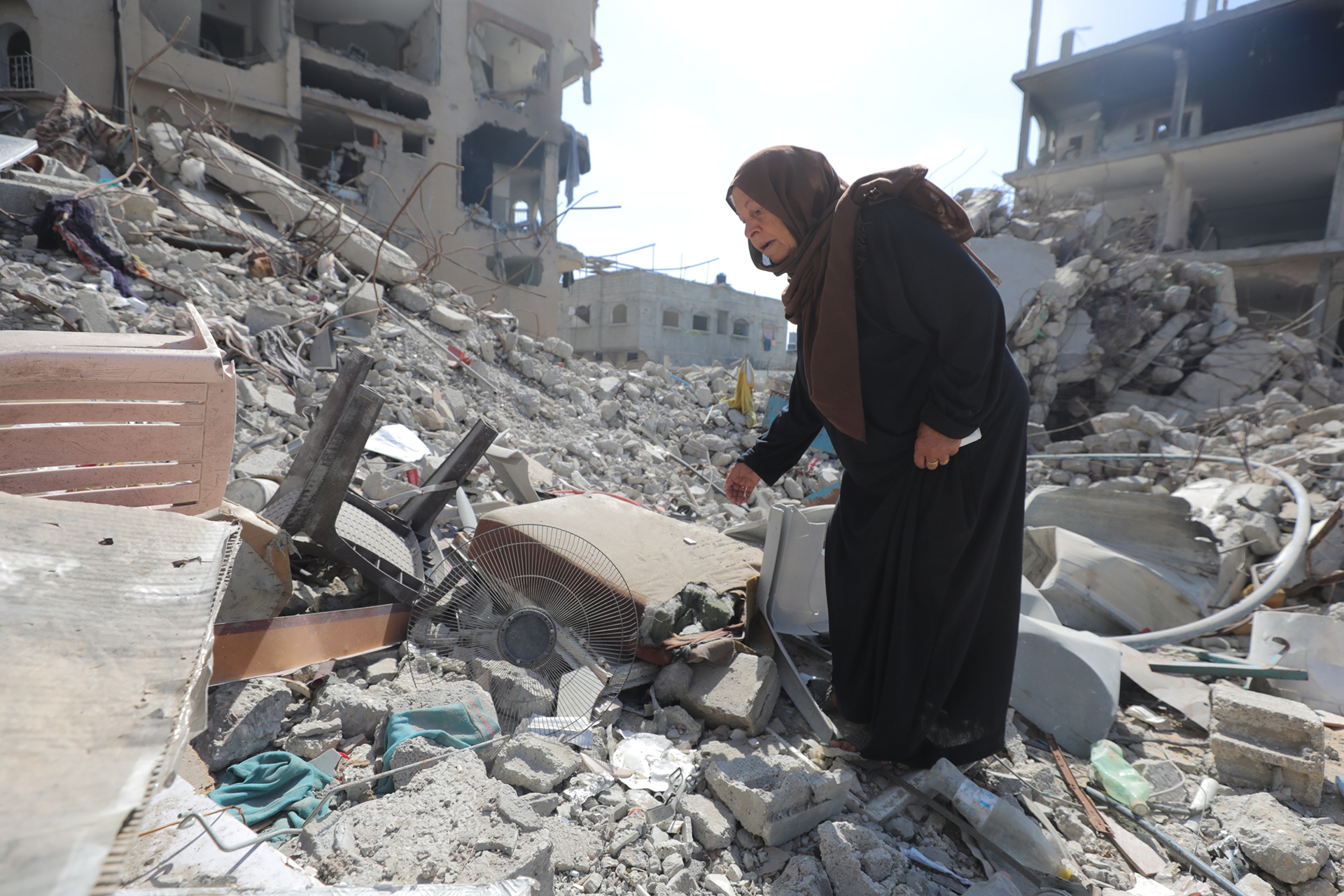
JULY – AUGUST 2024 Israel says Hamas’ military chief Mohammed Deif is killed in a July 13 Israeli airstrike. The strike in a designated humanitarian zone in southern Gaza kills at least 90 Palestinians, according to the Hamas-run territory’s health ministry.
Netanyahu addresses the U.S. Congress on July 24, emphasizing the importance of U.S.-Israeli ties and pledging “total victory” against Hamas, while dismissing opponents of the war. Dozens of congressional Democrats boycott the address and thousands of protesters in Washington, D.C. condemn Netanyahu’s visit and the war in Gaza.
A U.N. human rights office report released on July 31 details allegations of torture, sexual abuse, and degrading treatment made by Palestinians detained by Israeli authorities since the Oct. 7 attacks. The report also includes allegations that hostages taken from Israel by Palestinian armed groups on Oct. 7 were subjected to sexual violence, harsh treatment and dire conditions while held in Gaza.
Also on July 31, Hamas’ top political leader Ismail Haniyeh is assassinated in an Iranian government guesthouse in Tehran; Iran and Hamas blame Israel, though the government doesn’t formally claim responsibility. Hamas names Yahya Sinwar, the group’s top leader in Gaza and one of the chief architects of the Oct. 7 attacks, as its new political leader on Aug. 6.
SEPTEMBER 2024 On Sept. 1, the Israeli military announces it has recovered the bodies of six hostages from a tunnel in southern Gaza. The Israeli Ministry of Health says they were killed 48-72 hours before their autopsies. Hundreds of thousands across Israel protest Hamas’ killing of the hostages and the Israeli government’s failure to secure a deal to free the remaining hostages.
An Israeli strike on an area in southern Gaza that Israel designated a humanitarian zone kills at least 19 people on Sept. 10, according to Gaza’s health ministry. Israel says it targeted a Hamas “command and control” center there.
The U.N. World Health Organization completes the first round of a polio vaccination campaign in Gaza on Sept. 12, vaccinating about 556,000 children in the strip. The campaign is a response to a variant of poliovirus being detected in Gaza.
On Sept. 26, Palestinian National Authority President Mahmoud Abbas addresses the U.N. General Assembly. Abbas calls for Israel’s U.N. membership to be revoked, saying that the country is responsible for genocide and human rights violations against the Palestinian people. He criticizes the U.S.’s ongoing support of Israel.
The next day, in his own address to the UNGA, Israeli Prime Minister Netanyahu calls on Hamas to surrender and rejects the idea that the militant group can play any role in post-war Gaza.
The same day, Sept. 27, an Israeli air strike kills Hezbollah’s leader Hassan Nasrallah in Lebanon’s capital, Beirut. On Sept. 30, Israel announces a “limited” ground invasion in southern Lebanon, opening a new front of the war. An Israeli airstrike kills Fatah Sharif, Hamas’ leader in Lebanon. Sharif, formerly an UNRWA worker, had been placed on leave without pay in March after an investigation into his political activities.
An airstrike hits an apartment in central Beirut the same day — the first Israeli strike on central Beirut in almost two decades. Three members of the Popular Front for the Liberation of Palestine, whose armed wing has fought alongside Hamas in Gaza, are among those killed.
OCTOBER 2024 Iran launches 180 missiles at Israel on Oct. 1. Israeli officials say that most are shot down.
On Oct. 3, Israel carries out what becomes the deadliest strike in the West Bank since Oct. 7, 2023. The attack uses a warplane — rare in West Bank operations — and Israeli forces say at least nine Hamas militants are killed in Tulkarm. The Palestinian Health Authority says the attack killed at least 18 people. A family of four, including two young children, is among the dead, according to the family’s relatives.
On the same day, the U.N.’s World Food Program says that its humanitarian aid deliveries to vulnerable people in Gaza and the West Bank are being significantly hampered by “Israeli-imposed bureaucratic hurdles, lack of security guarantees within Gaza, insufficient border crossing points, and risk of criminal gangs looting” its convoys in southern Gaza.
The Israeli military launches a new invasion in Jabaliya, in northern Gaza on Oct. 6, 2024, saying that it wants to prevent Hamas from launching attacks from the city. Israeli strikes kill 32 people in areas of northern Gaza on Oct. 9, including a strike that medics say kills 15 people inside Al-Yemen Al-Saeed Hospital. Israel says that it killed 12 militants in the strikes. Philippe Lazzarini, the head of UNRWA, says Israel’s northern Gaza operations jeopardize the second phase of children’s polio vaccinations.
A Year of War: Israelis and Palestinians
U.S. Ambassador to the U.N. Linda Thomas-Greenfield says on Oct. 9 that investigations have found “a small percentage of UNRWA employees have ties to Hamas and other terrorist groups.” The U.N.’s internal watchdog investigated allegations related to UNRWA’s staff earlier in 2024, after which nine of the agency’s 13,000 employees were fired in 2024 for possible involvement in the Oct. 7 attacks. Thomas-Greenfield says U.N. and UNRWA staff are “vital to the humanitarian response in Gaza and face tremendous danger while performing their work.”
A report released by a U.N. commission on Oct. 10 finds that Israel has conducted “relentless and deliberate” attacks on Gazan medical personnel and facilities, which “constitute the war crimes of wilful killing and mistreatment and of the destruction of protected civilian property and the crime against humanity of extermination.” The report also concludes that both Israel and Palestinian armed groups have been responsible for torture and sexual and gender-based violence against Palestinian detainees and hostages taken from Israel, respectively. It says Israel and Hamas and other Palestinian armed groups have committed war crimes in this context as well. The Israeli government did not cooperate with the inquiry, and previously said that it had anti-Israel bias.
U.S. Secretary of State Antony Blinken and Defense Secretary Lloyd Austin send a letter to senior Israeli officials on Oct. 13, demanding Israel take actions to ensure aid delivery to civilians in Gaza. In the letter, the U.S. blames Israel for a severe decline in aid, particularly in northern Gaza, that contributes to widespread hunger.
Israel’s U.N. ambassador tells the Security Council on Oct. 16 that lack of aid is not the problem and that “Hamas has weaponized the humanitarian situation.”
On Oct. 17, Israel says it killed Hamas’ top leader Yahya Sinwar during a firefight between Israeli and Hamas forces in southern Gaza. Israeli officials say that his death was coincidental and not based on prior intelligence.
Staff at Indonesian Hospital say artillery hit the hospital on Oct. 18. They say they are surrounded by Israeli troops and don’t have enough water, food or supplies. The next day, Gaza’s health ministry says two patients died as a result of the siege and a power outage. The Israeli military says Hamas has used hospitals as “command and control bases,” that there had been no “intentional fire” at the hospital and troops had been “briefed on the importance of mitigating harm to civilians and medical infrastructure.” Gaza’s health ministry says Israel is increasing “its targeting of the health system” in northern Gaza, threatening the area’s medical infrastructure.
On Oct. 28, the Israeli parliament passes two laws banning UNRWA from operating on Israeli sovereign territory. The laws would make it harder for UNRWA to coordinate aid efforts in Gaza with the Israeli military. The laws come into effect three months later. The Biden administration says it is “deeply concerned” that the bills will exacerbate the humanitarian crisis.
NOVEMBER 2024 The International Criminal Court issues arrest warrants on Nov. 21 for Netanyahu and Yoav Gallant, who was Israel’s defense minister throughout the war until Nov. 5, for alleged war crimes. The ICC also issues a warrant for Hamas commander Mohammad Deif, whom Israel previously said its forces killed in a July airstrike in Gaza. Netanyahu decries the warrant as “antisemitic” and President Biden calls it “outrageous,” saying “there is no equivalence … between Israel and Hamas.”
Israel and Hezbollah agree to a ceasefire agreement on Nov. 27 that will halt fighting for two months. The deal requires Hezbollah to end its armed presence in much of south Lebanon and Israelis to return to their side of the border. Lebanese officials say Israel’s bombardment of Lebanon killed more than 3,700 people. More than 130 Israelis, around 80 of them soldiers, were killed in the conflict, according to the Israeli government.
JANUARY 2025 Negotiators for Israel and Hamas agree to a 42-day ceasefire on Jan. 15, with it set to take effect on Jan. 19. According to the terms of the agreement made public by some news outlets, Israeli forces would withdraw from Gaza’s population centers, and some 33 Israeli hostages along with hundreds of Palestinian prisoners would be released over the course of the ceasefire. In addition, many Palestinians would be able to return to their homes in Gaza and increased humanitarian aid would be delivered to the strip. The ceasefire agreement sets out multiple phases, some of which have yet to be fully negotiated and agreed on, but which could lead to the end of the war.
On Jan. 19, Hamas releases three female hostages. In exchange, Israel releases 90 Palestinian prisoners and detainees, most of whom are women and minors. Six days later, the next exchange takes place, with Israel releasing 200 Palestinian prisoners in exchange for four female Israeli soldiers. Of the 200 Palestinian prisoners released, some 120 of them had been serving life sentences.
On Jan. 21, Israel launches a major military operation in the West Bank, which Netanyahu says will be “extensive and significant.”
Hamas releases three Israeli and five Thai hostages in exchange for 110 Palestinian prisoners on Jan. 30. On the same day, Hamas confirms the death of Mohammad Deif, one of the alleged architects of the Oct. 7, 2023, attacks and also the subject of an ICC arrest warrant. Israel had announced his death in an Israeli airstrike six months prior.
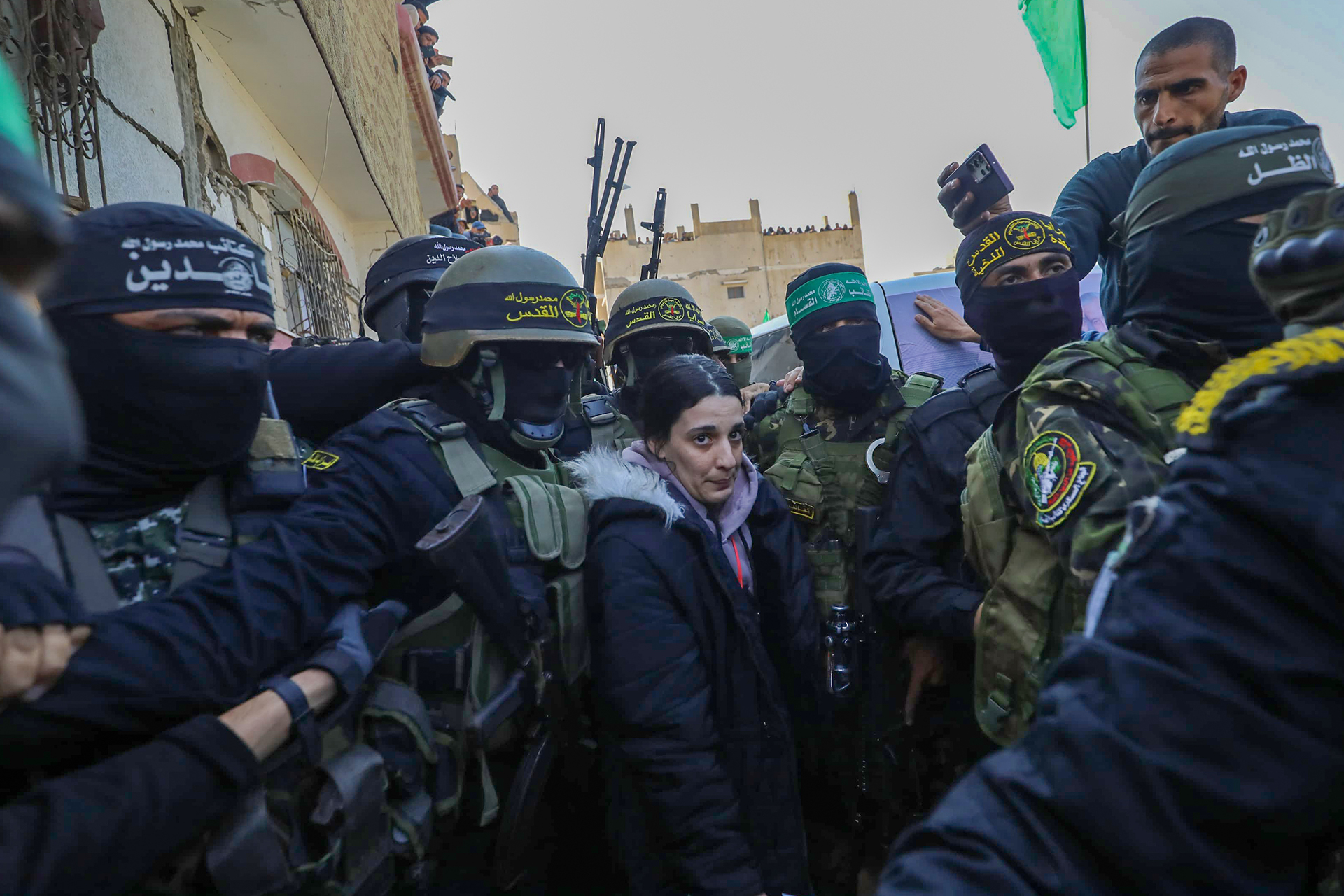
Israeli legislation banning UNRWA, the U.N.’s Palestinian refugee agency, from any activities in Israel comes into effect. UNRWA says that the law would “destroy” the U.N.’s humanitarian infrastructure in Gaza and ability to provide aid.
The war has displaced over 1.9 million Palestinians, according to U.N. estimates, and killed more than 46,000, mostly civilians, according to the Hamas-run territory’s health ministry. Some 75,000 Israeli residents remain displaced from towns bordering Gaza, according to Israel’s parliament. Hamas and other armed groups still hold 87 of the hostages abducted on Oct. 7 in Gaza, at least 34 of whom are dead, according to the Israeli government. Around 112,000 Lebanese residents and 68,000 residents of northern Israel remain displaced as a result of the conflict between Israel and Hezbollah.
This is an updated version of a timeline that was published on the FRONTLINE website on June 27, 2002, to accompany the 2002 documentary Shattered Dreams of Peace: The Road From Oslo.
Timeline updates from Sept. 1993 to June 2002 were adapted by Inci Sayki. Updates from April 30, 2003, to Sept. 10, 2024, were written by Inci Sayki. Updates from Sept. 16, 2024, to present were written by Refael Kubersky.

Email:
inci_sayki@wgbh.org
Email:
refael_kubersky@wgbh.orgRelated Documentaries
Latest Documentaries
Related Stories
Related Stories
Explore
Policies
Teacher Center
Funding for FRONTLINE is provided through the support of PBS viewers and by the Corporation for Public Broadcasting, with major support from Ford Foundation. Additional funding is provided the Abrams Foundation, Park Foundation, John D. and Catherine T. MacArthur Foundation, Heising-Simons Foundation, and the FRONTLINE Trust, with major support from Jon and Jo Ann Hagler on behalf of the Jon L. Hagler Foundation, and additional support from Koo and Patricia Yuen. FRONTLINE is a registered trademark of WGBH Educational Foundation. Web Site Copyright ©1995-2025 WGBH Educational Foundation. PBS is a 501(c)(3) not-for-profit organization.
